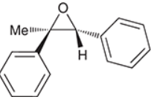
(a)
Interpretation: A starting material and reagents used to form following epoxide needs to be identified.

Concept introduction:
Preparation of epoxide-

Peroxy acids generally used in this process are MCPBA and peroxyacetic acid. Formation of epoxide via peroxy acid us a stereospecific process thus, cis substituents in alkene (starting material) remain at cis to each other in the epoxide (product). Similarly, trans substituents in alkene remain at trans to each other.
(b)
Interpretation: A starting material and reagents used to form following epoxide needs to be identified.

Concept introduction:
Preparation of epoxide- Epoxides can be prepared using peroxy acids. Alkenes are starting material in the preparation of epoxides with peroxy acids. Here, general reaction is represented as follows:

Peroxy acids generally used in this process are MCPBA and peroxyacetic acid. Formation of epoxide via peroxy acid us a stereospecific process thus, cis substituents in alkene (starting material) remain at cis to each other in the epoxide (product). Similarly, trans substituents in alkene remain at trans to each other.
(c)
Interpretation: A starting material and reagents used to form following epoxide needs to be identified.

Concept introduction:
Preparation of epoxide- Epoxides can be prepared using peroxy acids. Alkenes are starting material in the preparation of epoxides with peroxy acids. Here, general reaction is represented as follows:

Peroxy acids generally used in this process are MCPBA and peroxyacetic acid. Formation of epoxide via peroxy acid us a stereospecific process thus, cis substituents in alkene (starting material) remain at cis to each other in the epoxide (product). Similarly, trans substituents in alkene remain at trans to each other.
(d)
Interpretation: A starting material and reagents used to form following epoxide needs to be identified.

Concept introduction:
Preparation of epoxide- Epoxides can be prepared using peroxy acids. Alkenes are starting material in the preparation of epoxides with peroxy acids. Here, general reaction is represented as follows:

Peroxy acids generally used in this process are MCPBA and peroxyacetic acid. Formation of epoxide via peroxy acid us a stereospecific process thus, cis substituents in alkene (starting material) remain at cis to each other in the epoxide (product). Similarly, trans substituents in alkene remain at trans to each other.
Want to see the full answer?
Check out a sample textbook solution
Chapter 13 Solutions
ORGANIC CHEM PRINT STUDY GDE & SSM
- Would the following organic synthesis occur in one step? Add any missing products, required catalysts, inorganic reagents, and other important conditions. Please include a detailed explanation and drawings showing how the reaction may occur in one step.arrow_forward(a) Sketch the 'H NMR of the following chemical including the approximate chemical shifts, the multiplicity (splitting) of all signals and the integration (b) How many signals would you expect in the 13C NMR? CH3arrow_forwardDraw the Show the major and minor product(s) for the following reaction mechanisms for both reactions and show all resonance structures for any Explain why the major product is favoured? intermediates H-Brarrow_forward
- 3. Draw ALL THE POSSBILE PRODUCTS AND THE MECHANISMS WITH ALL RESONANCE STRUCTURES. Explain using the resonance structures why the major product(s) are formed over the minor product(s). H₂SO4, HONO CHarrow_forward7. Provide the product(s), starting material(s) and/or condition(s) required for the No mechanisms required. below reaction HO + H-I CI FO Br2, FeBr3 O I-Oarrow_forward6. Design the most efficient synthesis of the following product starting from phenot Provide the reaction conditions for each step (more than one step is required) and explain the selectivity of each reaction. NO MECHANISMS ARE REQUIRED. OH step(s) CIarrow_forward
- What is the skeletal structure of the product of the following organic reaction?arrow_forwardIf a reaction occurs, what would be the major products? Please include a detailed explanation as well as a drawing showing how the reaction occurs and what the final product is.arrow_forwardWhat is the major organic product of the following nucleophilic acyl substitution reaction of an acid chloride below?arrow_forward

 Organic ChemistryChemistryISBN:9781305580350Author:William H. Brown, Brent L. Iverson, Eric Anslyn, Christopher S. FootePublisher:Cengage Learning
Organic ChemistryChemistryISBN:9781305580350Author:William H. Brown, Brent L. Iverson, Eric Anslyn, Christopher S. FootePublisher:Cengage Learning

